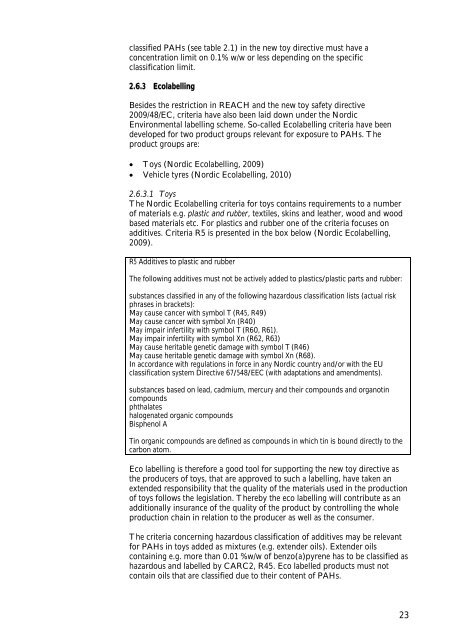PAHs in toys and childcare products - Miljøstyrelsen
PAHs in toys and childcare products - Miljøstyrelsen
PAHs in toys and childcare products - Miljøstyrelsen
You also want an ePaper? Increase the reach of your titles
YUMPU automatically turns print PDFs into web optimized ePapers that Google loves.
classified <strong>PAHs</strong> (see table 2.1) <strong>in</strong> the new toy directive must have a<br />
concentration limit on 0.1% w/w or less depend<strong>in</strong>g on the specific<br />
classification limit.<br />
2.6.3 Ecolabell<strong>in</strong>g<br />
Besides the restriction <strong>in</strong> REACH <strong>and</strong> the new toy safety directive<br />
2009/48/EC, criteria have also been laid down under the Nordic<br />
Environmental labell<strong>in</strong>g scheme. So-called Ecolabell<strong>in</strong>g criteria have been<br />
developed for two product groups relevant for exposure to <strong>PAHs</strong>. The<br />
product groups are:<br />
� Toys (Nordic Ecolabell<strong>in</strong>g, 2009)<br />
� Vehicle tyres (Nordic Ecolabell<strong>in</strong>g, 2010)<br />
2.6.3.1 Toys<br />
The Nordic Ecolabell<strong>in</strong>g criteria for <strong>toys</strong> conta<strong>in</strong>s requirements to a number<br />
of materials e.g. plastic <strong>and</strong> rubber, textiles, sk<strong>in</strong>s <strong>and</strong> leather, wood <strong>and</strong> wood<br />
based materials etc. For plastics <strong>and</strong> rubber one of the criteria focuses on<br />
additives. Criteria R5 is presented <strong>in</strong> the box below (Nordic Ecolabell<strong>in</strong>g,<br />
2009).<br />
R5 Additives to plastic <strong>and</strong> rubber<br />
The follow<strong>in</strong>g additives must not be actively added to plastics/plastic parts <strong>and</strong> rubber:<br />
substances classified <strong>in</strong> any of the follow<strong>in</strong>g hazardous classification lists (actual risk<br />
phrases <strong>in</strong> brackets):<br />
May cause cancer with symbol T (R45, R49)<br />
May cause cancer with symbol Xn (R40)<br />
May impair <strong>in</strong>fertility with symbol T (R60, R61).<br />
May impair <strong>in</strong>fertility with symbol Xn (R62, R63)<br />
May cause heritable genetic damage with symbol T (R46)<br />
May cause heritable genetic damage with symbol Xn (R68).<br />
In accordance with regulations <strong>in</strong> force <strong>in</strong> any Nordic country <strong>and</strong>/or with the EU<br />
classification system Directive 67/548/EEC (with adaptations <strong>and</strong> amendments).<br />
substances based on lead, cadmium, mercury <strong>and</strong> their compounds <strong>and</strong> organot<strong>in</strong><br />
compounds<br />
phthalates<br />
halogenated organic compounds<br />
Bisphenol A<br />
T<strong>in</strong> organic compounds are def<strong>in</strong>ed as compounds <strong>in</strong> which t<strong>in</strong> is bound directly to the<br />
carbon atom.<br />
Eco labell<strong>in</strong>g is therefore a good tool for support<strong>in</strong>g the new toy directive as<br />
the producers of <strong>toys</strong>, that are approved to such a labell<strong>in</strong>g, have taken an<br />
extended responsibility that the quality of the materials used <strong>in</strong> the production<br />
of <strong>toys</strong> follows the legislation. Thereby the eco labell<strong>in</strong>g will contribute as an<br />
additionally <strong>in</strong>surance of the quality of the product by controll<strong>in</strong>g the whole<br />
production cha<strong>in</strong> <strong>in</strong> relation to the producer as well as the consumer.<br />
The criteria concern<strong>in</strong>g hazardous classification of additives may be relevant<br />
for <strong>PAHs</strong> <strong>in</strong> <strong>toys</strong> added as mixtures (e.g. extender oils). Extender oils<br />
conta<strong>in</strong><strong>in</strong>g e.g. more than 0.01 %w/w of benzo(a)pyrene has to be classified as<br />
hazardous <strong>and</strong> labelled by CARC2, R45. Eco labelled <strong>products</strong> must not<br />
conta<strong>in</strong> oils that are classified due to their content of <strong>PAHs</strong>.<br />
23

















